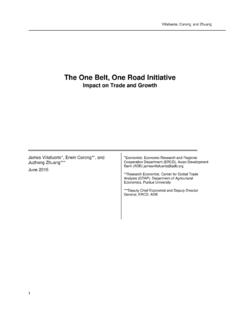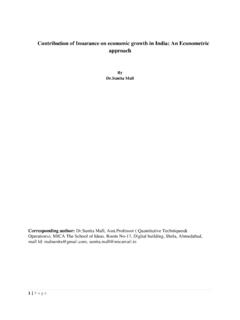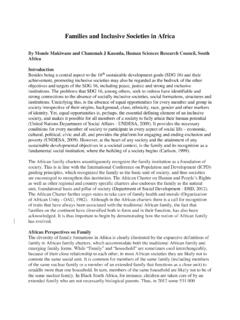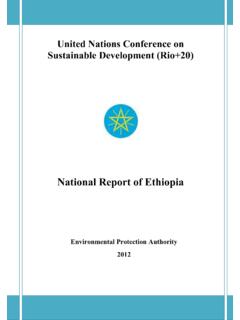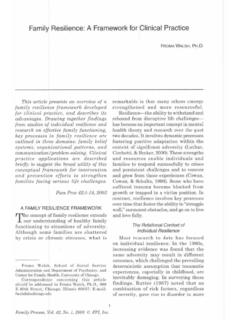Transcription of Gender Roles in Family Decision Making: Results from ...
1 14/04/2015 Gender Roles in Family Decision Making: Results from Indian States Dr. Surajit Deb. Affiliation: Associate Professor in Economics, Aryabhatta College, University of Delhi, India email: Abstract Basic Family decisions like desire to limit child-bearing, sex of the new-born or child care are not always an individual affair but involve interaction between choices of men and women in the Family . This study examines how background characteristics as well as decisions of men and women determine the Family outcomes such as, women s fertility, Family -size, sex preference of the new-born and children orphan-hood. Our analysis is performed using cross-sectional data pertaining to 29 states of India. The Results indicate that while men s preferences for male children remain as a significant barrier to fertility reductions, women s literacy level can contribute to the men s decisions of limiting Family -size.
2 The men s literacy along with women s lack of media exposure weakens women s desire for controlling Family -size and also enhances their preference for the male child. Finally, while alcohol use by men and literacy level or cash earning of women plays a role for the separation of children from their parents, the lack of wealth possession and men s literacy level seems to have prevented the abandonment of children across Indian states. Key Words: Family Decisions, Family Structure, Child Care, Cross-Sectional Models, India, Regional Dimensions. JEL Classification: D10, J12, J13, C21, O53, R11 Paper for 18th Annual Conference on Global Economic Analysis, Organized by Centre for Global Trade Analysis (Perdue University) and Centre for Policy Studies (Victoria University, Melbourne) Melbourne Convention Centre, Melbourne, Australia, 17-19 June 2015. 1 1 Gender Roles in Family Decision Making: Results from Indian States 1.
3 Introduction and Objective: The formation of Family and its structure across societies are expected to depend on the choices of men and women, but major Family decisions like the desire to limit child-bearing or the sex of the new-born also involve interaction of the men s and women s decisions in the Family . Although, the phenomena of high women s fertility or son-preference are apparent in the national-level estimates for India, there remain significant degrees of variation across states of India. Since the nature of co-operation (or conflict) commonly influence the Family - Decision , it is worthwhile to examine the extent to which Family decisions of women differ from that of the men. For instance, India and the northern-region states are familiar for the high women s fertility rates and their strong son-preference in the Family composition. It is of particular interest to make inquiries on whether the desire to limit child-bearing or son-preference is actually a desire of the men or women actors in the Family .
4 On the other hand, there are aspects of Family life, viz, domestic violence of the nature emotional, physical and sexual on the currently married women or the separation of children from their parents, which have been observed to bear a negative influence on the familial developments. The recent data (from National Family Health Survey III) suggest high prevalence of different forms of violence. , overall 39% of currently married women belonging to age 15-49 have ever experienced any physical or sexual or emotional violence in their current marriage and 27% have experienced the violence in the past 12 months. This indicates that the majority of currently married women who have ever been abused by their husbands are also currently being abused. Similarly, a sizeable proportion of children below age 18 years do not live with either parent even when both the parents are alive. It therefore remains imperative to analyze the interactions and impacts of women s and men s decisions on Family choices to understand how Family policies are evolved that makes happen various Family outcomes, viz.
5 , women s fertility, Family -size, sex preference of the new-born or nature of the child-care. In this background, this study examines how these Family outcomes are evolved from the choices and decisions of women and men by using 2 2 data from 29 Indian The plan for the rest of the paper is as follows. Section 2 discusses the Roles of Gender power in Family Decision making. In section 3, we focus on the major Family issues in India that have been highlighted by the previous research. Section 4 draws attention to recent aspects that are considered as essential determinants of Family Decision -making processes in India. The methodology of the empirical model, database and Results from our cross-sectional analysis on Indian states are presented in section 5. The conclusion and policy implications are contained in section 6. 2. Gender Role in Decision Making: Economists often believe that the Family Decision -making process is the outcome of conscious choices of each spouse, and the Decision -making power of each spouse is determined by economic as well as non-economic factors.
6 The Gender status is a vital aspect that influences the decisions of men and women in any Family , and the factors that influences the power that husbands or wives wield in a Family determines the Decision -making process of the unit. The academic literature on the area of consumer research has widely analyzed the choices of husbands and wives to understand the financial Decision -making process of the families (Ferber and Lee 1974, Rosen and Branbois 1983, Elder and Rudolph 2003, Bernasek and Bajtelsmit 2002). Similarly, the role of women or the female autonomy in the household Decision making process on health and Family planning have been examined by Anderson and Eswaran [2005], Furuta and Salway [2006], Acharya, et al [2010]. In a recent study, Bertocchi, Brunetti and Torricelli [2012] investigated the determinants of Family Decision making power on economic and financial choices by considering individual characteristics of each spouse, household characteristics, and Family background factors by using data over the period 1989-2010, which are drawn from the Bank of Italy Survey on Household Income and Wealth.
7 They found the probability that the wife is in charge of economic and financial decisions increased with the difference between her years of age, level of education, income, husband s characteristics, as well as household characteristics such as Family size and wealth. However, the Decision of fertility control is not an individual affair but involves individual or joint Decision making in the Family . Thus, the nature of cooperation existing 1 The states data that we consider are Andhra Pradesh, Arunachal Pradesh, Assam, Bihar, Chhattisgarh, Delhi, Goa, Gujarat, Haryana, Himachal Pradesh, Jammu and Kashmir, Jharkhand, Karnataka, Kerala, Madhya Pradesh, Maharashtra, Manipur, Meghalaya, Mizoram, Nagaland, Orissa, Punjab, Rajasthan, Sikkim, Tamil Nadu, Tripura, Uttarakhand, Uttar Pradesh, and West Bengal. 3 3 between the husband and wife affects the Decision on Family size and sex-choice of the new-born.
8 It is therefore implicit that the women s status remains particularly crucial for the Family Decision making. The Gender status depends on the Gender power, which may refer to access to education, money income, wealth, social Roles etc. It is predictable that there have been some changes on the women s status with regard to the authority and Decision -making mechanism of Indian Family system along with the access of education and media presence. The recent research-findings also seem to indicate that empowerment of women have impacted on the Family outcomes through its effects on the contraceptive-use and by weakening the son preference or by the spacing of children (Dyson and Moore 1983, Mason 1986, Malhotra et al. 1995, Presser and Sen 2000, Mason and Smith 2000, Jejeebhoy and Sathar 2001, Pande and Astone 2007). 3. Family Issues in India: The Family as an institution has undergone changes over several past decades in India, where earlier studies in the past have found the existence of a joint Family system (Mandelbaum, 1959, Gore, 1965, 1968).
9 The social and economic changes over the years had its impacts on the Indian Family structure, which endured changes in the Family -composition and generated various forms like joint Family , nuclear Family , nuclear Family with dependants, etc. (Ross 1961, Beteille 1964, Gore 1968, Kapadia, 1969, D'Souza 1971, Richard et al 1985). Subsequent studies found the rise of nuclear families over the years in many parts of the country (Niranjan 1998, Freed and Freed). The declining fertility levels have mainly been assigned as a reason for the reduction in Family size. However, there remain regional variations on the Family size in India, , southern states have smaller Family size than other parts of India, also the percentage of nuclear families are more prominent in urban areas than in rural areas. Studies have attempted to determine the socio- economic determinants of Family -composition in terms of differences in religion (Hindus and non-Hindus), castes, land-ownership, economic status, age, literacy level, place of residence, etc.
10 Several studies have confirmed the presence of son preference in the Family decisions of South Asian countries and linked it with the use of sex-selective abortions or female infanticide and high male/female sex ratios at birth (Das Gupta and Bhat 1997, Arnold et al 1998, Sudha and Rajan, 1999). The nexus among son preference, fertility behavior and Family composition has previously been highlighted in several studies (Rosenzweig and Schultz 1982, Behrman 1988, Kishore 1993, Murthi, Guio and Dreze 1995, Mutharayappa et 4 4 al 1997, Arnold et al 1998, Agnihotri 1999, Clark 2000, Miller 2001, Bandhyapadhyay 2003), whereby it is argued that a strong preference for sons has been the major stumbling block for reduction of women s fertility and Family -size in India. The contemporary research findings in India have indicated that the persistence of son preference had an impact not only on the preferred Family -composition, but also on the use of contraception, spacing as well as the number of children in the Family (Das Gupta 1987, Das Gupta and Bhat 1997, Clark 2000, Pande 2003, Pande and Astone 2007).






